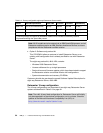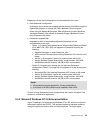
Chapter 3. Planning 91
additional logical processors and spawning multiple threads, which can exploit
the additional processing power.
As well as considering whether the operating system you are installing supports
Hyper-Threading, there may be licensing implications to consider before enabling
Hyper-Threading technology.
For a more detailed discussion on Hyper-Threading technology, refer to:
http://www.intel.com/eBusiness/products/server/processor/xeon/wp020901_sum.htm
Table 3-2 lists the supported operating systems for the x440 and the level of
support for Hyper-Threading technology provided by the operating system.
In the column titled Hyper-Threading Support:
None indicates the operating system does not recognize the logical
processors that Hyper-Threading enables.
Yes indicates that the operating system recognizes the logical processors and
can execute threads on them but is not optimized for Hyper-Threading.
Optimized indicates that the operating system recognizes the logical
processors and the operating system code has been designed to fully take
advantage of the technology.
Table 3-2 x440 operating system support
Description Release SMP support
1
Hyper-Threading
support
Windows 2000 Server SP2/3 Supports up to four-way Yes
Windows 2000 Advanced Server SP2/3 Supports up to eight-way Yes
Windows 2000 Datacenter Server SP3 Supports up to 32-way
2
Yes
Windows NT Enterprise Edition 4.0 Only supports four-way on the x440
Hot-plug PCI not supported
None
Windows .NET Server 1Q/03 Supports up to two-way Optimized
Windows .NET Enterprise Server 1Q/03 Supports up to eight-way Optimized
Windows .NET Datacenter Server 1Q/03 Supports up to 32-way
2
Optimized
NetWare 6.0 Supports up to 32-way
2, 3
Yes
Red Hat Linux Advanced Server 2.1 Supports up to eight-way
4
Yes
SuSE Linux Enterprise 8.0 Supports up to eight-way
4
Yes


















